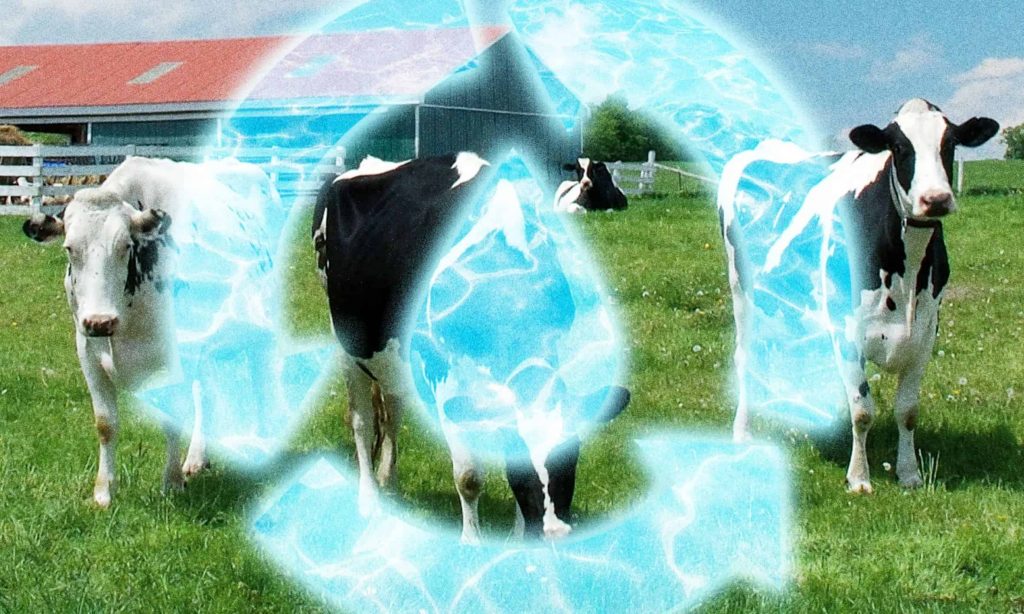
When Walt Moore’s great-grandfather began raising cows on the family’s Pennsylvania dairy farm in 1909, freshwater didn’t necessarily feel like liquid gold. As Moore’s grandfather and father went on to expand the farm, they had no issues with raising single crops — what today would be called monoculture — without worrying about how much water the growing operation would take.
For today’s dairy farmers, however, water is a front-and-center issue. “Definitely, I think in those generations it was an endless resource. Today it’s certainly not,” said Moore, whose farm now milks 1,050 Holsteins while also growing crops on 2,000 acres of land. “It’s a precious resource, and we’ve got to conserve it.”
The Innovation Center for U.S. Dairy has set ambitious climate goals for 2050, including achieving greenhouse gas neutrality, optimizing water use, and improving water quality. Reaching those goals will take significant individual and collective effort by farmers, along with industry advances in research and technology.
Yet great progress has already been made. Thanks to ongoing innovating and modernizing, producing a gallon of milk in 2017 required 30 percent less water and 21 percent less land, as well as had a 19 percent smaller carbon footprint, than it did a decade before in 2007, according to a study published in the Journal of Animal Science. In drought-prone California, water use intensity at dairies decreased 88 percent from 1964-2014, according to the Journal of Dairy Science. Since milk itself is 87 percent water, farmers know there’s virtually nothing more critical than effectively managing their water use.
:no_upscale()/cdn.vox-cdn.com/uploads/chorus_asset/file/24973997/VX23_DairyMGMT_1235152_BA1_Inset1__1_.png)
Water around the farm
A farmer like Moore who is looking to reuse more water begins almost like a homeowner would with an energy audit. Many dairy farms now recycle water multiple times, starting with water for the plate coolers, which chill the milk produced from 101 degrees when it emerges from the cow to about 38 degrees, the temperature needed to keep it fresh.
Water from plate coolers often goes on to be reused three or more places in a dairy operation. On Moore’s farm, along with many other farms across the U.S., it next becomes the cows’ drinking water. What isn’t consumed by the cows gets recycled into the cow-cooling sprinkler systems, and for washing down the milking center, both over and over.
Another starter step is checking all over the farm for faulty valves, which can easily leach water by the gallon. While simple, it’s not a one-time check — leaks can crop up regularly. Consistent monitoring is key to keeping water use steady and knowing when something changes. “You still find faulty valves — I just saw one two weeks ago,” Moore said ruefully.
Updating equipment can also provide chances to save. When building his new milking center in 2009, Moore reduced washing down the milking center from three times to two times daily, saving his farm approximately 225 gallons of water. The new washing system took different soaps and could be cleaned more easily, all contributing to slicing his water use.
Moore also changed procedures around his cows’ water bowls, to great results. Previously, he dumped them out three times per day, when each group of cows was being milked. He changed the protocol to dump them only once per day, scrub them once per week, and manually clean the area around them at each milking. “We have seen no reduction in the water consumed by the cows, but what we have seen is a 2,500-gallon water-use reduction daily,” he said.
Water content in feed
Up to 93 percent of a dairy’s water use goes toward feeding the cows, but it’s not just for drinking water. Water (including reused water) on the dairy is also used to grow the crops that become a cow’s food. And more and more, those crops are being grown with their water content in mind.
Adjusting to feed with higher water content means cows need to drink less water, explained Carlyn Peterson, a dairy technical manager who covers the Western U.S. for Selko, and whose PhD focused on ruminant nutrition and sustainability. Sorghum is considered an especially high-potential crop for drier climates, being more heat-tolerant and up to 40 percent more water-efficient than corn. The leftover sorghum silage “is wet like kimchi,” she said. “It’s kimchi for cows, with an almost fermented taste, and they love it.”
While sorghum silage doesn’t offer as many nutrients as traditional corn silage, hybrids are being developed to close that gap, Peterson said. Other new feedstuff options that are being explored with high water and energy contents include sugar beets and safflower.
Then there are the brewing byproducts that cows can feed on. Moist brewers’ grain, or beer mash, has long been fed to livestock. The rise in craft breweries — the U.S. went from 1,460 in 2006 to 9,247 by 2021 — has helped open up wider availability of brewing byproducts to local farmers. Working with nutritionists, who are typically plugged into what kind of feedstuffs are available where and from which producers, can help dairy farmers find nearby breweries and other operations with byproducts they can put to use for their cows.
Beyond feed, there’s still more to be done around reducing water use. Technology continues to help dairy farmers optimize their operations, helping with things like sensing when a cow is in a stall to be cooled and timing sprinkler systems down to the second. (One such smart soaker on the market saves up to 70 percent of the water used by a conventional cow soaking system.)
One hope is that artificial intelligence could even sense each cow’s body temperature and cool her down with a water temperature and duration tailored precisely for her. “We need research both at universities and the private companies that are driving AI to continue to improve the technology that directly affects water use,” Peterson said.
:no_upscale()/cdn.vox-cdn.com/uploads/chorus_asset/file/24973509/VX23_DairyMGMT_1235152_BA1_Inset2.png)
Crops and water
Dairy farmers have also been reimagining how they grow the crops that help feed the cows on their farm. Moore’s father took early steps that wound up saving water, like moving from “strip farming” in straight lines to “contour farming,” which better accommodated the farm’s rolling Pennsylvania hills — thereby helping with soil and water conservation. Planting vegetative buffers, including trees and small shrubs, along streams has also helped retain water on the farm while protecting community water quality.
Moore’s father had also begun experimenting with cover crops, which grow and cover the ground year-round — a practice Moore has continued and expanded with crops like crimson clover. “We were kind of toying with that, and as I’ve joined the business and been growing it, now we literally put a cover crop out on every acre every year,” he said. “It’s been neat to see the progression.”
Cover crops can be irrigated in part with cows’ manure and urine, which fertilizes them; in turn, the plants allow the nutrient-rich liquid to be better absorbed into the soil. Next, Moore is experimenting with subsurface drip irrigation, or piping wastewater directly into the soil. That could be more efficient, reducing evaporation into the air, although the resulting soil and water quality will need to be tested.
Moore has been working with the Stroud Water Research Center near him to try new water-reduction strategies and monitor the results. Another plan, in partnership with Brandywine Conservancy, is to experiment with a natural biochar filter, taking advantage of charcoal’s ability to remove impurities from water, and again to test the water quality afterward around the farm.
Together, these kinds of steps all help minimize runoff and conserve community water. “I was just reading about how there are areas in the United States where the water tables are at the lowest levels they’ve been since they’ve been recording them,” Moore said. “That stuff starts to worry me. We rely heavily on groundwater. The more I can conserve, the more it’s a win-win. If I’m pulling less out of the aquifer, there’s more for the neighbor. We’re part of the community, and we have to be good stewards.”
























